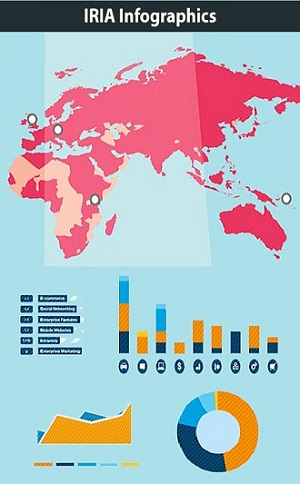China demonstrates military strength around Taiwan

China displays massive military power, advanced weapons, and tech, over the Taiwan issue
China has held its biggest-ever show of military force in and around Taiwan in the wake of a controversial visit to the island by U.S. House Speaker Nancy Pelosi. The drills displayed the country’s missiles, air force, and naval capabilities. Beyond the live-firing of ballistic missiles, Chinese warships, fighter jets, and drones around the island asserted Beijing not just as a regional power but a global power.
On August 8, China’s military announced that it is continuing large-scale military drills around Taiwan after the end of live-fire exercises as part of a series of drills, signaling that Beijing wanted to keep up pressure on the island. Chinese media reports suggested that such military exercises “will not stop and are expected to become routine” to push forward the reunification process."
During the heightened tensions over the island on 2021, China's President Xi Jinping said that “reunification” with Taiwan “must be fulfilled” and did not rule out the possible use of force to achieve this. Taiwan deems itself a sovereign state, while China views it as a breakaway province. Taiwan is an island, roughly 100 miles from the coast of southeast China. Taiwan is home to 23 million people and has its own democratically elected government.
Regional analysts believe that the recent show of military power is a demonstration of China’s growing military strength, which has significantly boosted its arsenal and naval force. The live-fire drills and simulating an attack on the island of Taiwan assert Beijing’s increased willingness to counter the threats in and around its territory and waters.
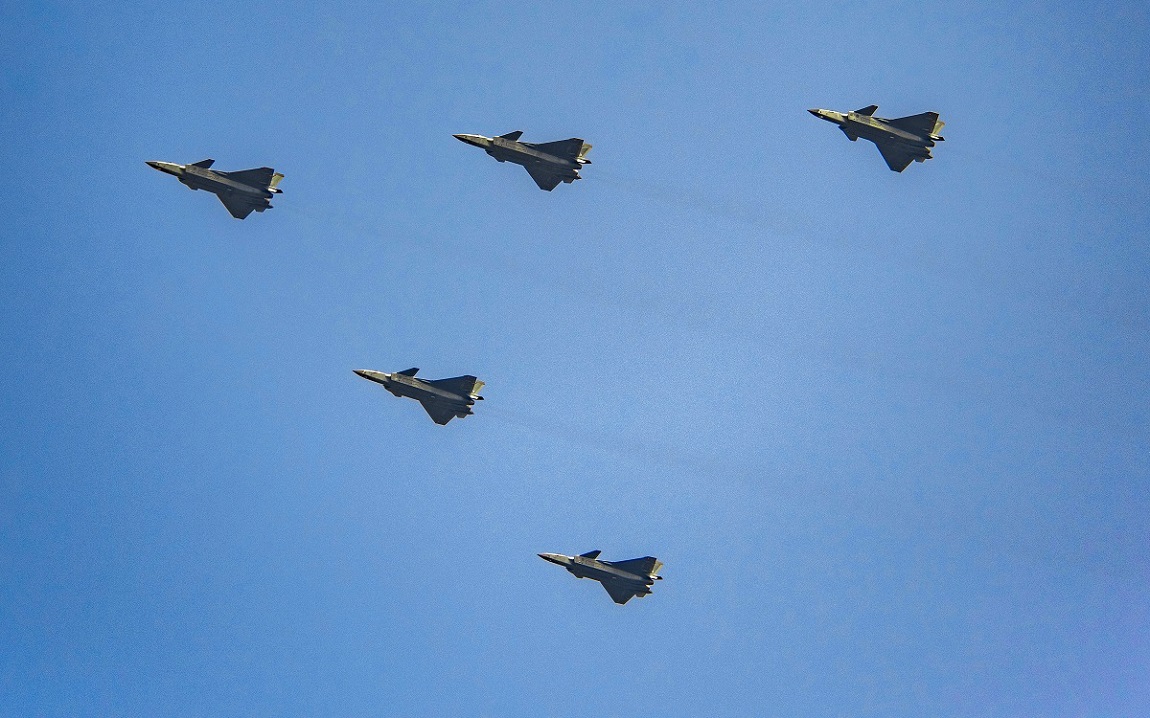 China’s J-20 stealth fighter jets flying in formation during the National Day Parade on October 1, 2019. (Image Credit: Creative Commons)
China’s J-20 stealth fighter jets flying in formation during the National Day Parade on October 1, 2019. (Image Credit: Creative Commons)
What weapons were put on display?
On August 4, 2022, China’s People’s Liberation Army (PLA) started conducting live-fire drills around Taiwan to initiate its large-scale and unprecedented military exercise in six maritime areas and air space around Taiwan after the visit of the third-most-senior figure in the U.S. government to Taiwan. The PLA engaged more than 100 fighter jets and bomber aircraft as well as 10 warships in the waters of the Taiwan Strait, according to a video released by the state broadcaster CCTV.
The military exercise involved the use of advanced weapons including J-20 stealth fighter jets and DF-17 hypersonic missiles after the drills. The J-20 fighter jet, H-6K bomber, J-11 fighter jet, Type 052D destroyer, Type 056A corvette, and DF-11 short-range ballistic missile were among the weapons used in the drills, Chinese media reported.
Taiwan said that Chinese warships and aircraft crossed the median line of the Taiwan Strait and that Taiwan’s armed forces dispatched air and naval patrols around the island, and activated land-based missile systems in response to the Chinese exercises. Taiwan emphasized that its military does not seek war, but would prepare and respond to it accordingly.
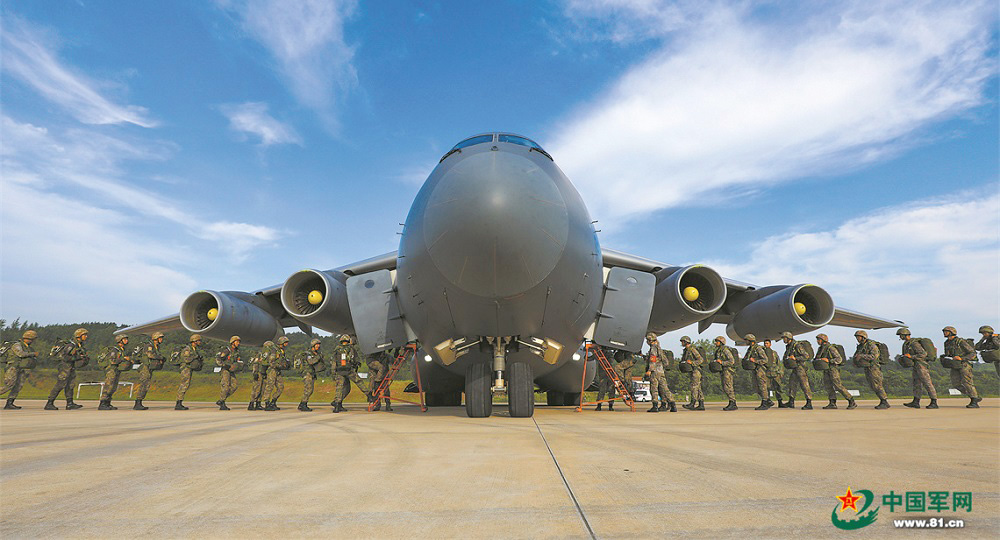 China’s Special operations soldiers assigned to the "Thunder" Commando of the PLA Air Force airborne troops line up to board the aircraft during a parachuting training exercise. (Image Credit: China Military Online)
China’s Special operations soldiers assigned to the "Thunder" Commando of the PLA Air Force airborne troops line up to board the aircraft during a parachuting training exercise. (Image Credit: China Military Online)
China fires Dongfeng missiles over Taiwan for the first time
On the first day of the drills, at least 11 Dongfeng long-range ballistic missiles were launched to hit the targets near the north, east, and south of Taiwan. Rockets were also fired around the islands of Matsu, Wuqiu, and Dongyin in the Taiwan Strait. It is the first time after 1966 that China has chosen these islands as the targets to conduct its live-fire military drills. The DF-11 is a short-range ballistic missile (SRBM) with a range of up to 600 km and is believed to be China’s first conventionally-armed SRBM.
The Chinese missiles flew over Taiwan Island for the first time, a Chinese military expert said. The conventional missiles flew over airspace covered by Taiwanese defense missiles, said Maj. Gen. Meng Xiangqing, a professor of strategy at the National Defense University in Beijing. “We hit the targets under the observation of the U.S. Aegis combat system and hit the area where the Patriot missile defense system is densely deployed, which means the Chinese military has solved the difficulties of hitting long-range targets on waters,” said Meng.
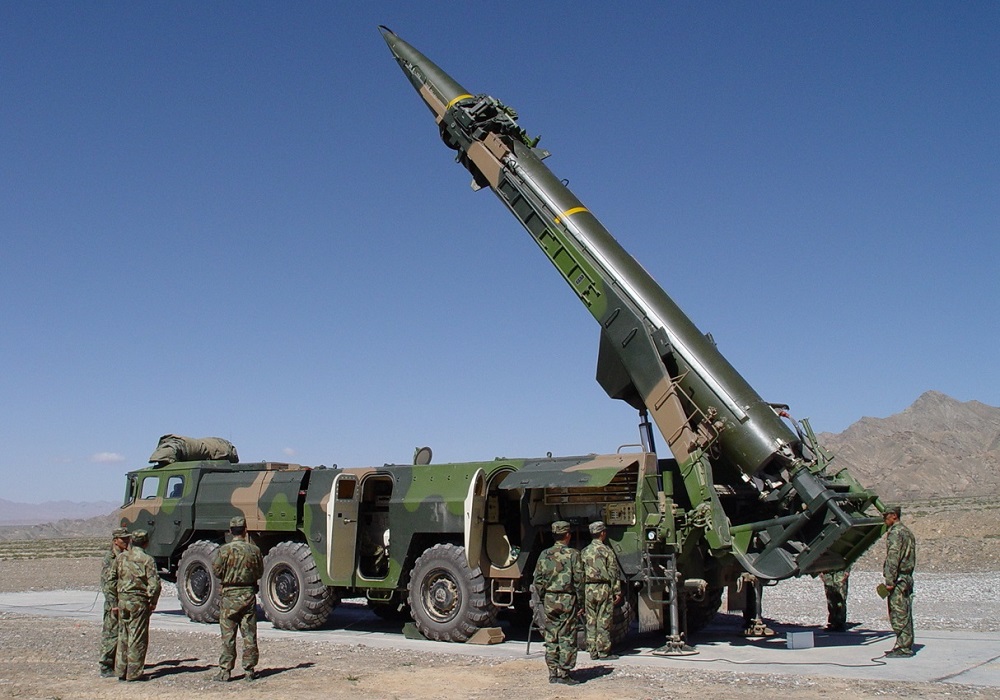 China’s Dong Feng-11 (DF-11A) short-range ballistic missile (SRBM) system. (Image Credit: SinoDefence)
China’s Dong Feng-11 (DF-11A) short-range ballistic missile (SRBM) system. (Image Credit: SinoDefence)
Chinese Air power
China mobilized hundreds of fighter jets, helicopters, and aircraft following Pelosi’s visit to Taiwan island. According to reports, PLA dispatched multi-type aircraft in its drills, including its latest J-20 stealth fighter jets, J-11, J-10, J-16, Su-30 jets, JH-7 fighter-bomber H-6K bomber, Shaanxi KJ-500 Airborne Early Warning and Control (AEW&C) aircraft, as well as Y-8EW, Y-8ASW, Y-9 EW planes.
China’s Aviation Regiment of Air Force of Eastern Theater Command Pilot Gong Yulong told CGTN that “During the [PLA] operation, we advanced according to orders, further familiarized ourselves with the battlefield environment, and verified our tactical methods, focusing on the capabilities of coordinated operations, ground assault, and precision strikes. This operation proved that we have the ability and means to carry out precise point-and-kill operations from the air to defeat any opponent.”
PLA Air Force Staff Department of Eastern Theater Command’s Section Director Wu Bian during an interview with the Chinese media outlet highlighted that the “mission was heavy, as the time was tight, the aircraft types were various and the sorties were numerous.” Wu added that the PLA Air Force conducted operations “in strict accordance with the standards and norms formed in the actual-combat training, and ensure the success of the air strike mission.”
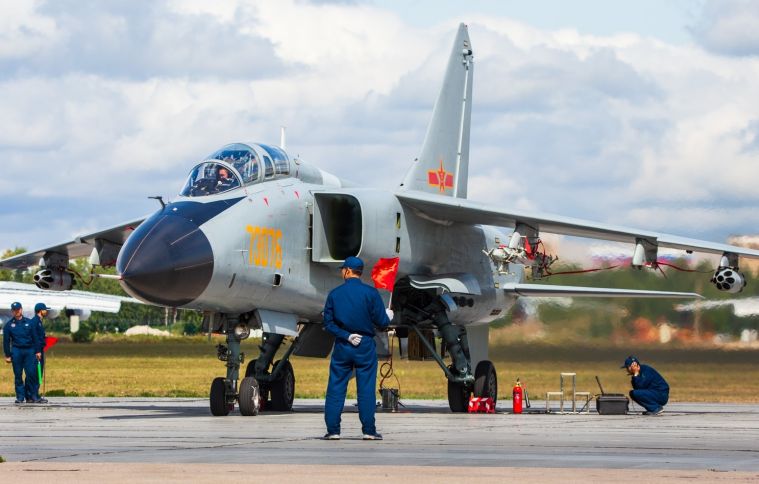 Chinese Air Force JH-7 aircraft photographed in August 2019 during the Aviadarts competition of the IAG held in Russia. (Image Credit: Russian Ministry of Defense)
Chinese Air Force JH-7 aircraft photographed in August 2019 during the Aviadarts competition of the IAG held in Russia. (Image Credit: Russian Ministry of Defense)
Chinese Naval power
China conducted anti-submarine operations and air-to-sea strikes in the “space near Taiwan Island” during the fresh military drills on August 8. “The eastern theatre of the Chinese People’s Liberation Army continued to carry out practical joint exercises and training in the sea and airspace around Taiwan island,” the Chinese military said. The exercises were “focusing on organizing joint anti-submarine and sea assault operations”.
Experts have claimed that China is currently building amphibious vessels and helicopters that can help stage a possible full-scale invasion of Taiwan if needed. China’s Type 055 destroyer, “the largest surface combatant currently being built in the world,” is compared with its U.S. and British counterparts, the U.S. Navy’s Ticonderoga-class cruiser, and the Royal Navy Type 45 in that order.
The People’s Liberation Army Navy (PLAN) is now the largest navy in the world and has surpassed the U.S. Navy in the number of battle force ships, according to the Department of Defense (DoD). PLAN has a battle force of approximately 355 platforms, including major surface combatants, submarines, aircraft carriers, ocean-going amphibious ships, mine warfare ships and fleet auxiliaries, and 85 patrol combatants and crafts that carry anti-ship cruise missiles (ASCMs). China has also been steadily modernizing its submarine force and operates a small number of nuclear-powered ballistic missile submarines (SSBNs).
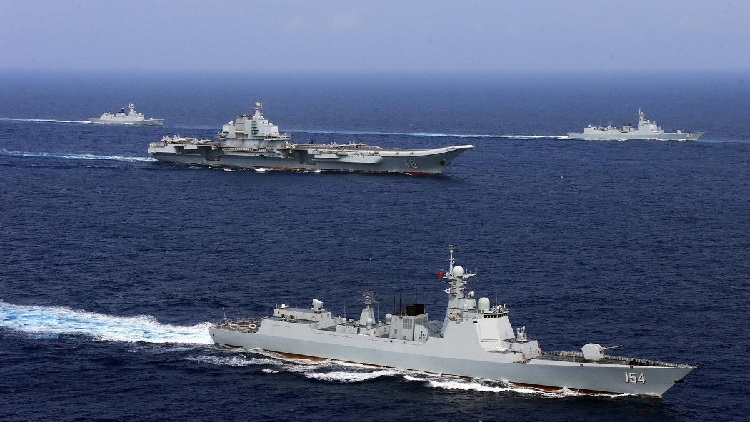 Chinese Navy ships including the aircraft carrier Liaoning (C) take part in a military drill in the western Pacific Ocean. (Image Credit: Reuters/via CGTN)
Chinese Navy ships including the aircraft carrier Liaoning (C) take part in a military drill in the western Pacific Ocean. (Image Credit: Reuters/via CGTN)
Taiwan blockade simulated
It’s the first time the Chinese military has staged such massive drills with a joint blockade of the island, sea assault, and land and air combat training. All PLA drill areas took place across the median line that divides the Taiwan Strait. Chinese media quoted experts saying that Chinese drills surrounding Taiwan are “intended to show that it is capable of blockading the entire island and of resolving the Taiwan question through non-peaceful ways, if the situation becomes irretrievable”.
China’s live-fire drills around Taiwan also simulated an economic blockade, posing a serious threat to major ports and shipping lanes in Taiwan. “This blockage style could be one of the action plans taken in the future for achieving the reunification by force,” according to Herman Shuai, a retired Taiwan lieutenant general, as quoted by Chinese media Global Times. If the PLA exercises continue for a long time, “it will constitute a substantial blockage of Taiwan” Shuai feared. Any conflict in the Taiwan Strait would severely impact global trade as the island’s east is a major route for ships transporting goods from East Asia to the United States and Europe.
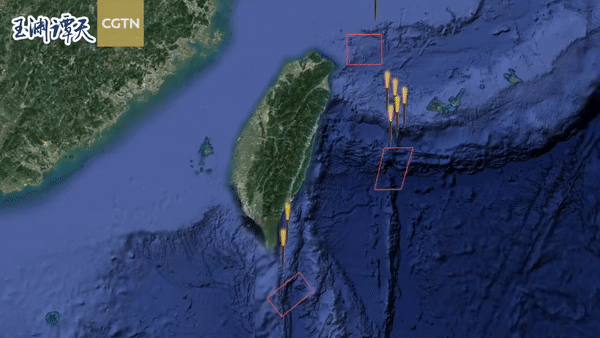 China launches live-fire drills near Taiwan. (Image Credit: CGTN)
China launches live-fire drills near Taiwan. (Image Credit: CGTN)
Chinese cyber and space technology
Besides the military, air force, and naval force, China’s space and cyber capabilities have significantly improved over the years. Before and after Nancy Pelosi’s, Taiwanese government websites experienced cyberattacks. Reports suggested that cyberattacks against official Taiwanese websites such as the presidential office and the ministry of foreign affairs doubled last week.
Western countries have recently accused Beijing of engaging in cyber warfare against governments and businesses. The FBI and MI5 chiefs have also warned that China is carrying out massive cyber espionage that poses a long-term threat to economic and national security. China, however, has consistently denied being involved in hacking and accused Washington of being the “largest source of cyber-attacks in the world.”
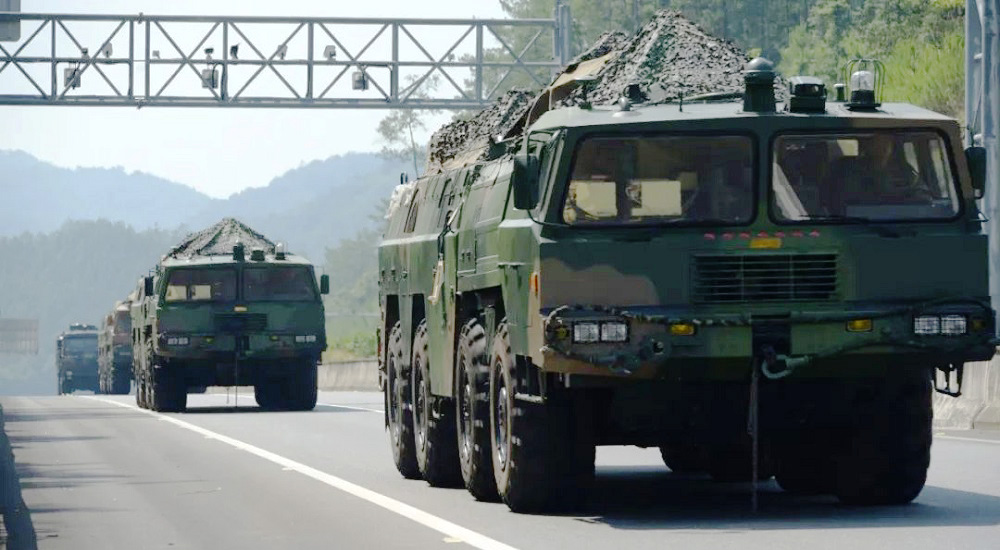 Trucks carrying missiles move near the exercise area as PLA Eastern Theater Command conducts joint training drills around Taiwan Island. (Image Credit: DongbuZhanqu/China Military Online)
Trucks carrying missiles move near the exercise area as PLA Eastern Theater Command conducts joint training drills around Taiwan Island. (Image Credit: DongbuZhanqu/China Military Online)
China halts military dialogue with the US
China called off formal talks with the United States on several issues including military-to-military channels and maritime consultations as Pelosi left the region. Pentagon, State Department, and White House officials condemned the move, describing it as an irresponsible overreaction. U.S. Secretary of State Antony Blinken has accused China of “irresponsible steps” by halting key communication channels with Washington.
On August 5, China officially announced countermeasures canceling Theater Commanders Talk, Defense Policy Coordination Talks, and Military Maritime Consultative Agreement meetings between the two countries. China also suspended cooperation with the United States on several key issues, such as transnational crimes, counternarcotics, cooperation on the repatriation of illegal immigrants, and legal assistance in criminal matters, as well as climate change talks.
ALSO READ:
Regions
Issues

















 What does Pelosi’s Taiwan trip mean for US-China relations?
What does Pelosi’s Taiwan trip mean for US-China relations? Highlights of 13th China International Aviation and Aerospace Exhibition
Highlights of 13th China International Aviation and Aerospace Exhibition









